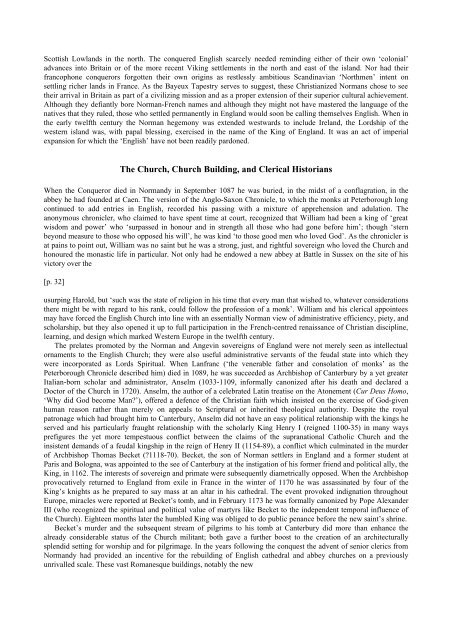THE SHORT OXFORD HISTORY OF ENGLISH LITERATURE
THE SHORT OXFORD HISTORY OF ENGLISH LITERATURE
THE SHORT OXFORD HISTORY OF ENGLISH LITERATURE
Create successful ePaper yourself
Turn your PDF publications into a flip-book with our unique Google optimized e-Paper software.
Scottish Lowlands in the north. The conquered English scarcely needed reminding either of their own ‘colonial’<br />
advances into Britain or of the more recent Viking settlements in the north and east of the island. Nor had their<br />
francophone conquerors forgotten their own origins as restlessly ambitious Scandinavian ‘Northmen’ intent on<br />
settling richer lands in France. As the Bayeux Tapestry serves to suggest, these Christianized Normans chose to see<br />
their arrival in Britain as part of a civilizing mission and as a proper extension of their superior cultural achievement.<br />
Although they defiantly bore Norman-French names and although they might not have mastered the language of the<br />
natives that they ruled, those who settled permanently in England would soon be calling themselves English. When in<br />
the early twelfth century the Norman hegemony was extended westwards to include Ireland, the Lordship of the<br />
western island was, with papal blessing, exercised in the name of the King of England. It was an act of imperial<br />
expansion for which the ‘English’ have not been readily pardoned.<br />
The Church, Church Building, and Clerical Historians<br />
When the Conqueror died in Normandy in September 1087 he was buried, in the midst of a conflagration, in the<br />
abbey he had founded at Caen. The version of the Anglo-Saxon Chronicle, to which the monks at Peterborough long<br />
continued to add entries in English, recorded his passing with a mixture of apprehension and adulation. The<br />
anonymous chronicler, who claimed to have spent time at court, recognized that William had been a king of ‘great<br />
wisdom and power’ who ‘surpassed in honour and in strength all those who had gone before him’; though ‘stern<br />
beyond measure to those who opposed his will’, he was kind ‘to those good men who loved God’. As the chronicler is<br />
at pains to point out, William was no saint but he was a strong, just, and rightful sovereign who loved the Church and<br />
honoured the monastic life in particular. Not only had he endowed a new abbey at Battle in Sussex on the site of his<br />
victory over the<br />
[p. 32]<br />
usurping Harold, but ‘such was the state of religion in his time that every man that wished to, whatever considerations<br />
there might be with regard to his rank, could follow the profession of a monk’. William and his clerical appointees<br />
may have forced the English Church into line with an essentially Norman view of administrative efficiency, piety, and<br />
scholarship, but they also opened it up to full participation in the French-centred renaissance of Christian discipline,<br />
learning, and design which marked Western Europe in the twelfth century.<br />
The prelates promoted by the Norman and Angevin sovereigns of England were not merely seen as intellectual<br />
ornaments to the English Church; they were also useful administrative servants of the feudal state into which they<br />
were incorporated as Lords Spiritual. When Lanfranc (‘the venerable father and consolation of monks’ as the<br />
Peterborough Chronicle described him) died in 1089, he was succeeded as Archbishop of Canterbury by a yet greater<br />
Italian-born scholar and administrator, Anselm (1033-1109, informally canonized after his death and declared a<br />
Doctor of the Church in 1720). Anselm, the author of a celebrated Latin treatise on the Atonement (Cur Deus Homo,<br />
‘Why did God become Man?’), offered a defence of the Christian faith which insisted on the exercise of God-given<br />
human reason rather than merely on appeals to Scriptural or inherited theological authority. Despite the royal<br />
patronage which had brought him to Canterbury, Anselm did not have an easy political relationship with the kings he<br />
served and his particularly fraught relationship with the scholarly King Henry I (reigned 1100-35) in many ways<br />
prefigures the yet more tempestuous conflict between the claims of the supranational Catholic Church and the<br />
insistent demands of a feudal kingship in the reign of Henry II (1154-89), a conflict which culminated in the murder<br />
of Archbishop Thomas Becket (?1118-70). Becket, the son of Norman settlers in England and a former student at<br />
Paris and Bologna, was appointed to the see of Canterbury at the instigation of his former friend and political ally, the<br />
King, in 1162. The interests of sovereign and primate were subsequently diametrically opposed. When the Archbishop<br />
provocatively returned to England from exile in France in the winter of 1170 he was assassinated by four of the<br />
King’s knights as he prepared to say mass at an altar in his cathedral. The event provoked indignation throughout<br />
Europe, miracles were reported at Becket’s tomb, and in February 1173 he was formally canonized by Pope Alexander<br />
III (who recognized the spiritual and political value of martyrs like Becket to the independent temporal influence of<br />
the Church). Eighteen months later the humbled King was obliged to do public penance before the new saint’s shrine.<br />
Becket’s murder and the subsequent stream of pilgrims to his tomb at Canterbury did more than enhance the<br />
already considerable status of the Church militant; both gave a further boost to the creation of an architecturally<br />
splendid setting for worship and for pilgrimage. In the years following the conquest the advent of senior clerics from<br />
Normandy had provided an incentive for the rebuilding of English cathedral and abbey churches on a previously<br />
unrivalled scale. These vast Romanesque buildings, notably the new









